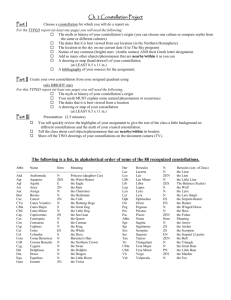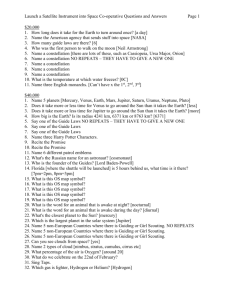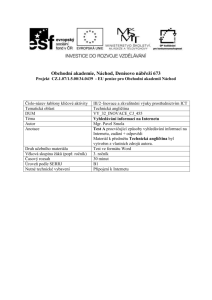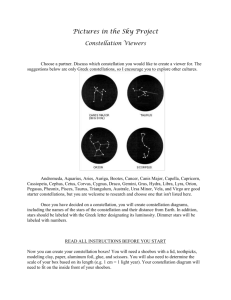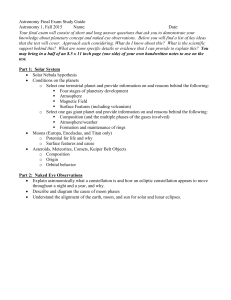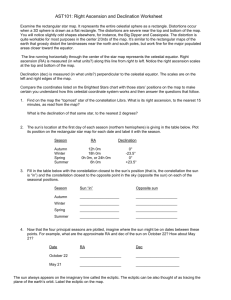Constellation Brands, Inc. NYSE: STZ Current Price - $24.20
advertisement
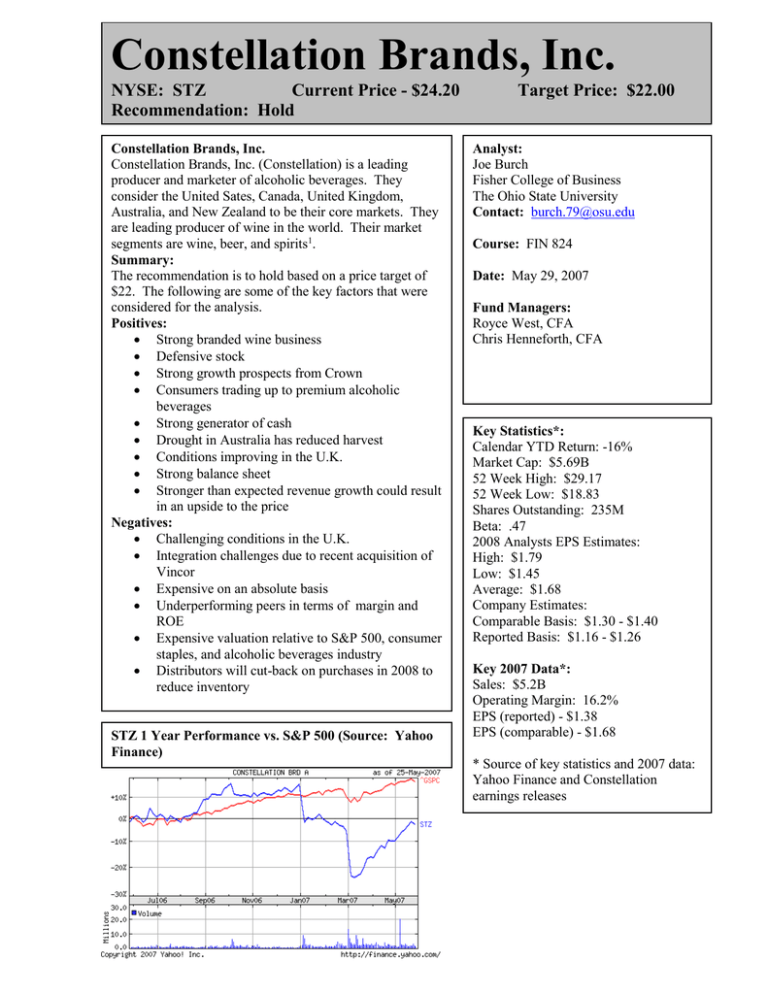
Constellation Brands, Inc.
NYSE: STZ
Current Price - $24.20
Recommendation: Hold
Constellation Brands, Inc.
Constellation Brands, Inc. (Constellation) is a leading
producer and marketer of alcoholic beverages. They
consider the United Sates, Canada, United Kingdom,
Australia, and New Zealand to be their core markets. They
are leading producer of wine in the world. Their market
segments are wine, beer, and spirits1.
Summary:
The recommendation is to hold based on a price target of
$22. The following are some of the key factors that were
considered for the analysis.
Positives:
Strong branded wine business
Defensive stock
Strong growth prospects from Crown
Consumers trading up to premium alcoholic
beverages
Strong generator of cash
Drought in Australia has reduced harvest
Conditions improving in the U.K.
Strong balance sheet
Stronger than expected revenue growth could result
in an upside to the price
Negatives:
Challenging conditions in the U.K.
Integration challenges due to recent acquisition of
Vincor
Expensive on an absolute basis
Underperforming peers in terms of margin and
ROE
Expensive valuation relative to S&P 500, consumer
staples, and alcoholic beverages industry
Distributors will cut-back on purchases in 2008 to
reduce inventory
STZ 1 Year Performance vs. S&P 500 (Source: Yahoo
Finance)
Target Price: $22.00
Analyst:
Joe Burch
Fisher College of Business
The Ohio State University
Contact: burch.79@osu.edu
Course: FIN 824
Date: May 29, 2007
Fund Managers:
Royce West, CFA
Chris Henneforth, CFA
Key Statistics*:
Calendar YTD Return: -16%
Market Cap: $5.69B
52 Week High: $29.17
52 Week Low: $18.83
Shares Outstanding: 235M
Beta: .47
2008 Analysts EPS Estimates:
High: $1.79
Low: $1.45
Average: $1.68
Company Estimates:
Comparable Basis: $1.30 - $1.40
Reported Basis: $1.16 - $1.26
Key 2007 Data*:
Sales: $5.2B
Operating Margin: 16.2%
EPS (reported) - $1.38
EPS (comparable) - $1.68
* Source of key statistics and 2007 data:
Yahoo Finance and Constellation
earnings releases
Table of Contents
Company Overview ......................................................................................................................... 3
Segments ..................................................................................................................................... 3
Wines .......................................................................................................................................... 3
Beers ........................................................................................................................................... 3
Spirits .......................................................................................................................................... 4
Economic/Macro ............................................................................................................................. 4
Sector/Industry/Sub-Industry .......................................................................................................... 5
Sector - Consumer Staples .......................................................................................................... 5
Industry/Sub Industry - Alcoholic Beverages/Distillers & Vintners........................................... 5
Wine Industry.............................................................................................................................. 6
Growth Drivers/Catalysts/Positives/Issues ...................................................................................... 6
Critical Initiatives from 2006 ...................................................................................................... 6
Capitalizing on the Trend of Trading up ..................................................................................... 7
Operational Improvements .......................................................................................................... 7
Inventory buildup at the distributors ........................................................................................... 7
Company Management ............................................................................................................... 7
Pricing ......................................................................................................................................... 8
Risk/Concerns ............................................................................................................................. 8
Financials......................................................................................................................................... 8
Income Statement ........................................................................................................................ 8
Sales ........................................................................................................................................ 8
Positive sales outlooks ............................................................................................................ 8
Margins ................................................................................................................................... 9
SG&A ..................................................................................................................................... 9
Balance Sheet ............................................................................................................................ 10
Working Capital.................................................................................................................... 10
Other Balance Sheet Ratios .................................................................................................. 10
Cash Flow ................................................................................................................................. 11
DCF Assumptions:................................................................................................................ 11
DCF Target Price .................................................................................................................. 11
Performance Relative to Alcoholic Beverage Industry ........................................................ 12
Valuation ....................................................................................................................................... 12
Absolute Valuation Chart.......................................................................................................... 13
Absolute Valuation Table ......................................................................................................... 13
Relative to S&P 500 Table........................................................................................................ 14
Relative to Consumer Staples Sector Table .............................................................................. 14
Relative to Alcoholic Beverages Industry Table....................................................................... 14
Conclusion ..................................................................................................................................... 15
Endnotes ........................................................................................................................................ 16
Supporting Tables and Charts ....................................................................................................... 17
Income Statement and Income Statement Ratios ...................................................................... 17
Balance Sheet and Balance Sheet Ratios .................................................................................. 18
Cash Flow Statement ................................................................................................................ 19
Discounted Cash Flow .............................................................................................................. 20
Income Statement ...................................................................................................................... 21
Constellation Relative to S&P 500 ........................................................................................... 22
Constellation Relative to Consumer Staples ............................................................................. 23
Consumer Staples Relative to Alcoholic Beverages ................................................................. 24
2
Company Overview
The following is an overview of Constellation Brands (Constellation) verbatim from the
company website.
“Constellation Brands, Inc. (NYSE: STZ, ASX: CBR ), headquartered in Fairport, New
York, is a leading international producer and marketer of beverage alcohol brands with a
broad portfolio across the wine, imported beer (into the United States) and spirits
categories. Constellation is the largest wine company in the world by volume; the largest
multi-category supplier of beverage alcohol in the United States and Canada; a leading
producer and exporter of wine from Australia, New Zealand and Canada; and both a
major producer and independent drinks wholesaler in the United Kingdom.”2
Segments
Constellation categories their business segments as wines (branded and
wholesale), beers, and spirits. The following charts show the revenue by segment and the
year-over-year organic growth (2007 vs. 2006) on a constant currency basis.3
Revenue by Segm ent
Spirits
6%
Imported
Beers
20%
Branded
Wine
53%
Organic Sales Change
(Constant Currency)
Branded Wine
4%
Wholesale Wine
4%
Imported Beers
15%
Spirits
1%
Total
6%
2376
1062
1044
329
4811
Wholesale
Wine
21%
Wines
Wine is Constellations largest segment in terms of revenue with the combination
of branded wine and wholesale wine making up 74% of revenues. They hold nearly a
20% share of the US according to their company website. Constellation Wines U.S.
consists of 4 businesses: Icon Estates, Centerra Wine Company, Pacific Wine Partners,
and North Lake Wines. Their Australian division, Hardy Wine Company, is Australia’s
largest wine producer. Constellations Europe Ltd is one of the largest premium drink
companies in Europe. In June of 2006 Constellation acquired Vincor, the top Canadian
wine company. Some well known brands produced and distributed by the Constellation
brands include Robert Mondavi, Arbor Mist, Cook’s, and 3 blind moose.2
Beers
Beers made up 20% of constellation revenue in 2007. Constellation participates
in the Beer market through a joint venture Crown Imports LLC formed with Grupo
Modelo on January 2, 2007. Their focus is on importing and marketing beer in the U.S.
3
The Crown Imports portfolio includes well known brands such as Corona Extra, Corona
Light, Modelo Especial, and St. Pauli Girl.2
Spirits
The spirits segment made-up 6% of company revenues in 2007. Constellation’s
spirits division, Barton Brands, is a leader in the American value market but is looking to
grow in the premium sector. Their purchase of SVEDKA during fiscal 2007
demonstrates their growth strategy into the premium market. SVEDKA is the fastest
growing major spirits import brand with an 8% market share in the imported Vodka
category in the US (source 3/19/07 press release).2
Economic/Macro
Since Constellation is part of a defensive sector, I did not expect the price to be
highly correlated with economic data. A regression of 10 years of percent price changes
versus 10 years of GPD and Interest rate percent changes supported my hypothesis. The
p-value indicates no statistical significance. Consumer staples will not be significantly
impacted by rising interest rates and reduced GDP as other more cyclical sectors would.
SUMMARY OUTPUT
Fed Funds % Change Line Fit Plot
Price %
Change
Regression Statistics
Multiple R
0.124302717
R Square
0.015451165
Adjusted R Square
-0.010458014
Standard Error
0.164348138
Observations
40
-0.5
1
0.5
0
-0.5 0
Price % Change
0.5
1
Predicted Price %
Change
Fed Funds % Change
ANOVA
df
Regression
Residual
Total
Intercept
Fed Funds % Change
1
38
39
SS
0.016107834
1.026391793
1.042499628
MS
F
Significance F
0.016107834 0.596358725
0.444747268
0.02701031
Coefficients
Standard Error
0.055238157
0.026103747
-0.095517236
0.123688112
t Stat
P-value
2.116100667 0.04094502
-0.772242659 0.444747268
Lower 95%
Upper 95% Lower 95.0% Upper 95.0%
0.002393884 0.10808243 0.002393884
0.10808243
-0.345910726 0.154876253 -0.345910726 0.154876253
SUMMARY OUTPUT
Price %
Change
GDP % Change Line Fit Plot
Regression Statistics
Multiple R
0.033575252
R Square
0.001127298
Adjusted R Square
-0.025158826
Standard Error
0.165539343
Observations
40
1
0.5
0
-0.01 -0.5 0
Price % Change
0.01
0.02
Predicted Price %
Change
GDP % Change
ANOVA
df
Regression
Residual
Total
Intercept
GDP % Change
1
38
39
SS
0.001175207
1.04132442
1.042499628
Coefficients
Standard Error
0.045425912
0.04625385
1.094166998
5.283571641
MS
F
Significance F
0.001175207 0.042885652
0.837046479
0.027403274
t Stat
P-value
0.982100121 0.332262376
0.207088514 0.837046479
Lower 95%
Upper 95% Lower 95.0% Upper 95.0%
-0.048210112 0.139061935 -0.048210112 0.139061935
-9.601864505 11.7901985 -9.601864505
11.7901985
4
Sector/Industry/Sub-Industry
Constellation falls under the consumer staples sector. They are a member of the
alcoholic beverages industry and their specific sub-industry is distillers and vintners.
Brown-Foreman Corporation is the only other S&P500 company in this specific sub
industry. Therefore, I look to the more broad alcoholic beverages sector for some
comparisons.
Sector - Consumer Staples
Consumer staples consist of household necessities that people use on a daily
basis. These items represent a small portion of an individual’s personal income.
The companies tend to be in the mature stage of their lifecycle and usually exhibit
slow growth.
Staples companies are generally considered defensive (non-cyclical) stocks. As
opposed to cyclical stocks which can fluctuate significantly with changes in the
economic cycle, staples companies are relatively immune to changes in the
economic cycle. Consumers tend to purchase the products regardless of the state
of the economy. For this reason, the demand for the products is considered stable
and inelastic. And therefore, the sales and earnings of the companies tend to be
constant.
Due to the mature nature, the sector tends to be highly competitive with large
branded players as well as generic providers fighting for their piece of the
consumer’s expenditure.
Furthermore, brand is extremely important. A strong brand will allow a company
in the staples sector to demand higher prices, thus, generating higher margins
which can be reinvested for product innovation and growth.
The slow growth nature of the staples sector also leads companies to look
internationally for sales. International sales are a positive in today’s environment
both due to the pure market size of the global market as well as the week status of
the dollar. For example, a US company generating sales internationally can
convert those foreign dollars to a larger amount of US dollars.
Staples companies tend to generate large amounts of cash. Furthermore, they tend
to pay high dividend yields.
Staples companies can be a good edge against economic downturn. Growth
opportunities exist when institutional investors move large amounts investment
away from cyclical stocks and into staple in tough economic times.
Staples companies become less desirable when economic growth is strong and
investors prefer to invest in stocks that can generate higher returns
Industry/Sub Industry - Alcoholic Beverages/Distillers & Vintners
Constellation is consistent with the broader staples sector in many ways. Similar to
necessities, consumers are going to continue to spend money on alcoholic beverages
regardless of the state of the economy. Constellation is looking internationally for
growth. Brand is extremely important for constellation as a means to earn higher
margins. Constellation like other staples companies generates large amount of cash.
Constellation has used aggressive acquisition as a way to grow their business and create
5
economies of scale. Constellation is different from the broader staples sector in that it
does not pay a dividend.
Key trends in the alcoholic beverage industry include consolidation among importers,
producers, distributors, and retailers. In addition, the growth of imported alcoholic
beverages is exceeding domestic growth. Finally, consumers are trading up to premium
brands (source: Standard and Poor’s).4
Wine Industry
Competitive Conditions in the U.K.
One of the most critical issues that Constellation faced during fiscal year 2007
was the challenging competitive conditions in the U.K. market. These conditions made it
difficult for Constellation to cover their costs in the market.3
The UK situation was highlighted by CEO Richard Sands during the fiscal 2007
earnings call. A huge over supply of grapes from the 2006 harvest in Australia has
resulted in an oversupply of bulk wine shipped from Australia to the U.K. In addition,
the large grocers have consolidated in the U.K. The combination of these two conditions
has enabled the large grocers to quickly bring low cost private label wine to the U.K.
market. The high availability and low price of the private label brands has created
pricing pressure and reduced the margins of the Constellation branded wines sold in the
U.K.5
Magnifying the challenges in the UK, was a duty increase that came in higher
than expected during 2006. This puts the wines being imported into the UK at a
disadvantage.5
Many feel that the conditions in Australia and the U.K. will improve. In an article
from Wall Street Journal on May 25, 2007, Susan Murdoch explains how Australia’s
worst drought in 100 years as well as some damage related to frost has resulted in a
reduction in this year’s harvest.6 The Constellation earnings release indicated that the
drought and frost could reduce the 2007 harvest by 25-30 percent.3
While Constellation highlighted the positive impact of the drought conditions,
some analyst, such as David Cooke from ABN Amro, believe that in the extreme case the
drought conditions could potentially have serious detrimental impact on the wine
industry. Cooke believes that if the drought conditions continue for years, the significant
grape shortage would offset any benefits achieved in the form of higher prices.6
Based on the expert’s findings, I believe the reduction the 2007 and 2008 harvest
will have a positive impact on Constellation’s wine revenues and profits in the U.K. I am
not concerned about the long-term impact of the drought at this time.
Growth Drivers/Catalysts/Positives/Issues
Critical Initiatives from 2006
CEO Robert Sands identified 4 key activities in 2007 that will position the
business for Growth: The acquisition of Vincor in June of 2006, the formation of Crown
Imports in January 2007, the acquisition of SVEDKA completed in March 2007, and the
organizational and operational improvement initiative.5
6
Capitalizing on the Trend of Trading up
A key strategy highlighted by the executive team is to invest more in the higher
end wines, beers, and spirits. The team highlighted the trend, especially in the US, of
consumers trading up to premium brands. This is good for Constellation because it lines
up with their strategy. The higher end bands generate higher margins for Constellation.
The benefit of this trend is that these products represent higher margins. They have taken
several actions during the past year to capitalize on this trend.5
With the purchase of SVEDKA in 2006, Constellation now controls the fastest
growing premium spirits brand in the US. On the 2007 earnings call they reported that
this brand had 60% growth in 2006.5
The purchase of Vincor in 2006 also created an opportunity for Growth. CEO
Robert Sands said that the purchase has allowed them entrance into a 5th market –
Canada. He also highlighted that fact that the acquisition will enhance the premium
product portfolio.5
I see the trend of consumers trading up having a positive impact on revenue and
margin growth in 2008 and beyond.
Operational Improvements
Sands emphasized that Constellation is not sitting idle waiting for the conditions
in the UK to improve. They have launched a restructuring effort in the UK to reduced
cost and improve operational efficiencies. Constellation is building a new bottling
facility in the UK. Among other benefits, they are expecting reduced costs and improved
asset utilization. The project will begin to have an impact on earnings in 2009. The new
facility will allow Constellation to close multiple warehouses. In addition, it will allow
for the shipment of more bulk (rather than bottled) wine into the UK. This is expected to
generate significant ocean freight savings.5
Inventory buildup at the distributors
Constellation has kicked off a program to allow their distributors to reduce
inventory during 2008. This will mean reduced sales for Constellation as they allow the
inventories to deplete. On the positive side, Constellation believes that the distributors
will use the savings from the reduced inventory, to invest in marketing and distributing
the Constellation brands.5 I do not anticipate positive impacts from this initiative until
2009.
Company Management
A key change was jut completed when 10-year CFO Tom Summer retired and
was replaced by Robert Ryder.
Constellation talked in their earnings conference about a realignment of global
reporting structure that they believe preserves their decentralized operating model
while ensuring optimal import, export, operation capabilities, and resource
utilization.5
7
Pricing
Pricing pressures have been significant in the U.K. However, I expect these
pressures to relax slightly in 2008 and more so in 2009.
Constellation is currently raising prices on their wholesale brands.5 This could
put downward pressure on revenues if volumes decrease as a result.
Risk/Concerns
Integration Risk: Constellation will be faced with execution challenges as they
continue to integrate Vincor into their portfolio.
Challenging UK market: While I believe that conditions will improve the UK, it
could take longer than expected.
Regulatory: Increase duties in the UK market.
Change of consumer tastes. A change in the economy could lead to a slow down
in the trade up trend.
There is risk that the cost savings from restructuring efforts will be less than
expected or take longer than expected to materialize.
Financials
Income Statement
Sales
Over the past 5 years, revenue has grown from $2.7B to $5.2B. Year-over-year
growth has ranged from 48% in 2003 to 13% in 2007. The largest driver of revenue
growth has been acquisitions. While overall revenue was up13% in 2007, organic growth
on a constant currency basis was 7%.3 I expect Constellation to continue to look for
opportunities to increase revenues through acquisitions. I also expect them to invest in
the marketing of their current brands to accelerate the revenue growth. Constellation is
projecting low single digit sales growth in 2008. While this looks like a negative trend,
Sands explained that after accounting for the distributor inventory reduction initiative and
the equity approach to reporting Crown imports, Constellation is actually going to be
achieving strong growth in 2008.5
The inventory reduction initiative will results in a reduction of $160-190M of
sales (3-3.5% of 2007 revenue). Reporting Crown and Matthew Clark Wholesale
business as equity investments will also reduce top line sales. However, the free cash
flow generated from Crown and Matthew Clark will be distributed to its partners and
entered into the income statement on the equity earnings line. Due to these accounting
changes, Constellation projects a 30-32% decrease in revenue.5 Excluding the impact of
the accounting change, I expect sales to increase 4% in 2008.
Positive sales outlooks
Constellation expects low single digit growth in branded wine, branded
spirits, and wholesale.5
Branded wine in the US and Canada are expected to show high growth.5
8
Constellation expects strong performance from Crown.
The following chart illustrates the revenue growth at Constellation during the past 10
years.
Dollars (Millions)
10-Year Revenue Trend
6000
5000
4000
3000
2000
1000
0
Revenues ($ Mil)
1998 1999 2000 2001 2002 2003 2004 2005 2006 2007
year
Margins
While gross margins and operating margins improved from 2006 to 2007, pre-tax
profit remained roughly flat. I expect margins to remain flat in 2008. Restructuring
efforts and synergies from the Vincor acquisition and increased sales of premium
products in the US will provide upward pressure on margins, while continued price
pressures in the U.K. will put downward pressure on margins. The following chart shows
the 5-year margin analysis.5
Margin Analysis
35
30
Percentage
25
Gross Prof it Margin (%)
20
Operating Prof it Margin
EBITDA (%)
15
Pre-Tax Prof it Margin
(%)
10
5
0
2003
2004
2005
2006
2007
Ye ar
SG&A
SG&A as a percent of sales has increased from 12.9% in 2003 to 14.7% in 2007.
Constellation attributed this increase to a change in the reporting method of stock
compensation expense.5 I expect SG&A as a percent of sales to level off in 2008 and
then decrease slightly in 2009 as a result of restructuring, lay-offs, and synergies from the
Vincor acquisition.
9
Balance Sheet
Working Capital
The five year trend in working capital causes some concerns. Specifically, days
of inventory has risen from 151 days in 2003 to 192 days in 2007. This equates to less
than two inventory turns per year. Inventory as a % of sales has also increased during the
past several years.
Working capital will continue to be at high levels during 2008 as Constellation
allows their distributors to reduce their inventories. Sands explained that while they are
allowing their distributors to reduce their inventories, Constellation inventories will grow.
While fewer purchases from the distributors will result in lower accounts receivable,
Sands explained that the negative impact of increased inventories at Constellation will
more than offset the positive working capital benefit of lower accounts receivable.5
I project that constellation will begin achieving inventory reductions in 2009.
This will help them to reduce their working capital.
The following chart shows that accounts receivable and accounts payable have
remained roughly level as a percent of sales between 2006 and 2007. I project that they
will remain level as a percentage of sales going forward.
Inventory, AR, AP
0.45
0.4
0.35
0.3
Inventory as % of sales
0.25
0.2
Accounts receivable as
% of sales
0.15
0.1
Accounts payable as %
of sales
0.05
0
2003
2004
2005
2006
2007
Other Balance Sheet Ratios
The quick ratio has decreased over the past several years. Rising inventories have
likely played a factor. However, I am not concerned about Constellations ability to meet
their short term obligations. The 2007 current ratio is also at a healthy level.
Constellation has made more productive use of their plant in equipment in recent years
resulting in an increase in the plant and equipment turnover. Asset turnover has remained
flat.
Overall, Constellation has a healthy balance sheet. The biggest area for
improvement is the management and reduction of inventory.
10
5
4.5
4
Quick Ratio
3.5
Current Ratio
3
2.5
Asset Turnover
2
1.5
Plant & Equipment
Turnover
1
0.5
0
2003
2004
2005
2006
2007
Cash Flow
DCF Assumptions:
A terminal growth rate of 4% was used because a company cannot continue to
achieve higher than market growth in the long-term.
A discount rate of 9.0% was used. A defensive company such as STZ is going to
have lower than average risk. This is reflected in the low beta as measured by
analysts such as The Street.com (.51)9 and Ford Equity Research (.80)10 and
Standard and Poor’s (.51)4
Margins are projected to remain roughly flat going forward for the reasons
described earlier.
Due to Crown and Matthew Clark converting to an equity method of reporting,
Constellation net sales will be down 30-32% in fiscal 2008 based on company
guidance. However, organic sales are expected to grow in the low single digits.7
Therefore, I increased equity earnings on the income statement to offset the sales
decrease.
Due to the 30-32% projected decrease in net sales, I could no longer tie inventory
to percentage of sales. I assumed a slight increase in inventories in 2008 based on
company guidance.
Capital expenditures will remain roughly level at 3% of sales, but will decrease
slightly to converge with depreciation and amortization.
Depreciation and amortization will remain level at approximately 2.7% of sales.
The tax rate of 40% was used based on company guidance.7 I assumed this rate
would continue for the next 10 years.
DCF Target Price
From the DCF, my target price of $23. The following sensitivity analysis shows the
various target prices that would obtained with different sales growth and discount rate
assumptions.
11
Sale
Growth
6%
7%
8%
8.5%
$25
$27
$28
Discount Rate
9.0%
9.5%
$23
$21
$24
$22
$25
$23
Performance Relative to Alcoholic Beverage Industry
I looked a Constellations performance relative to the alcoholic beverage industry.
I found that they are currently underperforming on a pre-tax margin basis. Over the past
10 years they have averaged a pre-tax margin of 89% of that of the industry. They
currently have a pre-tax margin of 84% of that of the industry. They are also
underperforming the industry on a return on equity basis. Over the past 10 years they
have been averaging a ROE of 95% of that of the industry. They currently have a ROE
of 87% of that of the industry. The comparison of pre-tax margin and ROE illustrates
that Constellation is underperforming compared to how they have historically performed
relative to the industry.8
Valuation
I looked at the valuation of Constellation in terms of price/forward earnings, price/sales,
price/earnings before interest, taxes, depreciation, and amortization (EBITDA), and
price/cash flow.
12
Absolute Valuation Chart
Absolute valuation reveals that Constellation is expensive on a P/Forward E and
P/CF basis, but cheap on a P/EBITDA basis and in-line on a price/sales basis. From the
absolute valuation, I conclude that Constellation is expensive. I put most weight on
P/Forward E. Constellation is currently trading at 16.7 times forward earnings. This is
relatively expensive compared to their 5 year-average. Reversion to the man would
indicate that the stock will eventually revert to a P/E of 14.4.
Absolute Valuation Table
Ratio
High
Low
Mean
P/Forward
E
P/S
16.7
9.0
14.4
1.67
.76
1.12
P/EBITDA
10.3
4.2
7.1
P/CF
17.1
7.8
11.1
Current Target
Target
Multiple E,S,B/share
16.7
14.4
1.34
(from DCF)
1.11
1.4
15
(From DCF)
6.2
7.1
3.9
{(P/S)
/(P/EBITDA)}
11.7
11.1
2.07
{(P/S)/(P/CF)
Target
Price
19.30
21
27.69
22.98
13
To arrive at the multiples I assumed reversion to the mean for all ratios except for
P/S. Constellation sales will be down 30-32% in 2008 because more of their earning will
be coming from equity investments. This decrease in sales should not result in a decrease
in earnings or share price. Therefore, I expect them to have a higher P/S multiple in the
future. Based on absolute valuation and multiples, my target price is $20.
Relative to S&P 500 Table
Ratio
P/Forward E
P/S
P/EBITDA
P/CF
High
1.40
1.11
1.39
1.47
Low
.55
.52
.56
.71
Mean
.75
.75
.91
.97
Current
1.10
.81
.80
.99
Constellation normally trades at a P/ Forward E factor of .75 compared to the
S&P 500. However, they are currently trading a factor of 1.10. They are relatively
expensive on a P/Forward E and P/S basis, cheap on a P/EBITDA basis, and in-line on a
P/CF basis. Overall, I consider Constellation to be expensive relative to the S&P500.
Relative to Consumer Staples Sector Table
Ratio
P/Forward E
P/S
P/EBITDA
P/CF
High
1.20
1.45
1.07
1.22
Low
.52
.62
.45
.55
Mean
.80
.95
.68
.78
Current
.94
.98
.62
.85
Constellation normally trades at a P/ Forward E factor of .80 compared to the
consumer staples sector. However, they are currently trading a factor of .94. They are
relatively expensive on a P/Forward E and P/CF basis, slightly cheap on a P/EBITDA
basis, and relatively in-line on a P/S basis and. I consider Constellation to be expensive
relative to the consumer staples sector.
Relative to Alcoholic Beverages Industry Table
Ratio
P/Forward E
P/S
P/EBITDA
P/CF
High
1.32
1.31
1.49
1.62
Low
.59
.51
.52
.67
Mean
.90
.85
.83
1.07
Current
1.07
.62
.66
.98
Constellation normally trades at a P/ Forward E factor of .90 compared to the
alcoholic beverages industry. However, they are currently trading a factor of 1.07. They
are relatively expensive on a P/Forward E but relatively cheap based on the other ratios.
Since I put must weight on the P/Forward E ratio, I consider Constellation to be
expensive relative to the alcoholic beverages industry.
14
Conclusion
Based on a valuation target price of $20 and a DCF target price of $23, my final
target price is $22. My target represents a 9% downside potential. The following is a
summary of the positive and negative issues impacting the performance of the stock that
have led to may decision to hold.
Positives:
Strong branded wine business
Defensive stock
Strong growth prospects from Crown
Consumers trading up to premium alcoholic beverages
Strong generator of cash
Drought in Australia has reduced harvest
Conditions improving in the U.K.
Strong balance sheet
Stronger than expected revenue growth could result in an upside to the price
Negatives:
Challenging conditions in the U.K.
Integration challenges due to recent acquisition of Vincor
Expensive on an absolute basis
Underperforming peers in terms of margin and ROE
Expensive valuation relative to S&P 500, consumer staples, and alcoholic
beverages industry
Distributors will cut-back on purchases in 2008 to reduce inventory
15
Endnotes
1. Constellation 10-k.
2. Constellation website, http://www.cbrands.com.
3. Constellation fiscal 2007 year-end earnings press release, “Constellation
Brands Reports Record Net Sales, EPS for Fiscal 2007,” April 5, 2007.
4. Standard and Poor’s Stock Report, May 19, 2007.
5. Constellation Fiscal 2007 Earnings Conference Call, April 5, 2007.
6. Susan Murdoch, “Drought Crops 2007 Grape Harvest,” Wall Street Journal,
May 25, 2007.
7. Constellation press release, “Constellation Brands Announces U.K. Joint
Venture for Matthew Clark Wholesale Business,” April 17, 2007.
8. StockVal
9. TheStreet.com Ratings, April 9, 2007.
10. Ford Equity Research, May 18, 2007.
16
Supporting Tables and Charts
Income Statement and Income Statement Ratios
17
Balance Sheet and Balance Sheet Ratios
18
Cash Flow Statement
19
Discounted Cash Flow
Terminal Discount Rate 9.0%
=
Terminal FCF Growth = 4.0%
2008E
2009E
2010E
2011E
2012E
2013E
2014E
2015E
2016E
Terminal
2017E Value
3651
3870
6.00%
4102
6.00%
4,349
6.00%
4,610
6.00%
4,886
6.00%
5,179
6.00%
5,490
6.00%
5,819
6.00%
6,169
6.00%
Operating Income
Operating Margin
639
17.50%
677
17.50%
738
18.00%
783
18.00%
830
880
932
988
1048
1110
18.00% 18.00% 18.00% 18.00% 18.00% 18.00%
Interest and Other- net
Interest % of Sales
-301
-8.25%
-310
-8.00%
-328
-8.00%
-304
-7.00%
-323
-7.00%
Year
Revenue
% Growth
Taxes
-215
Tax Rate
-40.00%
Equity Income, net
200
% of sales
5.47%
Equity Income Growth Assumption
Net Income
% Growth
Add Depreciation/Amort
% of Sales
% of Capex
Plus/(minus) Changes WC
% of Sales
Subtract Cap Ex
Capex % of sales
Free Cash Flow
YOY growth
-232
-254
-40.00% -40.00%
212
224
5.47%
5.47%
-293
-6.00%
-311
-6.00%
-275
-5.00%
-291
-5.00%
-308
-5.00%
-191
-203
-235
-249
-285
-303
-321
-40.00% -40.00% -40.00% -40.00% -40.00% -40.00% -40.00%
238
252
267
283
300
318
337
6.00%
6.00%
6.00%
304
352
6.00% 15.64%
6.00%
6.00%
6.00%
6.00%
373
428
6.00% 14.83%
454
6.00%
481
6.00%
322
348
7.80%
381
9.54%
287
-24.61%
97
2.67%
0.00%
-61
-1.67%
110
3.00%
103
2.67%
0.00%
-28
-0.74%
116
3.00%
110
2.67%
0.00%
-30
-0.74%
123
3.00%
116
2.67%
0.00%
-32
-0.74%
130
3.00%
123
2.67%
0.00%
-34
-0.74%
133
2.89%
130
2.67%
0.00%
-36
-0.74%
141
2.89%
138
2.67%
0.00%
-38
-0.74%
150
2.89%
147
2.67%
0.00%
-41
-0.74%
147
2.67%
155
2.67%
0.00%
-43
-0.74%
155
2.67%
165
2.67%
0.00%
-46
-0.74%
165
2.67%
249
306
23%
337
10%
240
-29%
260
8%
305
17%
323
6%
388
20%
411
6%
436
6%
Terminal
P/E
NPV of free cash flows
NPV of terminal value
Projected Equity Value
Free Cash Flow Yield
$1,944.1
$3,510.5
5,454.6
4.57%
Shares Outstanding
241.0
Current Price
24.17
Implied equity value/share
22.63
Upside/(Downside) to DCF
-6.4%
Free Cash Yield
20
9,058.5
18.826667
4.81%
Income Statement
Sales
COGS
SG&A
Acquisition-Related Integration Costs
Restructuring and Related Charges
Operating Income
Interest Expense
Gain on change in fair value of derivative instruments
Equity in earnings of equity method investees
Earnings from Cont Ops before Taxes
Income Tax
Net Earnings from continuing ops
Discontinued Operations (net of taxes)
Earnings of discont ops
Gain on sales of discont ops
Net earnings from discont ops
2010
2009
2008
2007
4102.5 3870.3
3651.2 5216.0
(2830.7) (2670.5) (2519.3) (3692.5)
(533.3) (522.5) (492.9) (768.8)
0.0
0.0
0.0
(23.6)
0.0
0.0
0.0
(32.5)
738.4
677.3
639.0
698.6
(328.2) (309.6) (301.2) (268.7)
0.0
0.0
0.0
55.1
224.3
211.6
199.6
49.9
634.5
579.3
537.3
534.9
(253.8)
380.7
(231.7)
347.6
(214.9)
322.4
(203.4)
331.5
2006
4603.4
(3278.9)
(612.4)
(16.8)
(29.3)
666.0
(189.7)
0.0
0.8
477.1
2005
4087.6
(2947.0)
(555.7)
(9.4)
(7.6)
567.9
(137.7)
0.0
1.8
432.0
2004
3552.4
(2576.6)
(457.3)
0.0
(31.1)
487.4
(144.7)
1.2
0.5
344.4
(152.0)
325.1
(155.5)
276.5
(124.0)
220.4
Average of
2003 historic values
2731.6
(1970.9)
(351.0)
0.0
(10.0)
(4.8)
(21.1)
404.9
(105.4)
23.1
15.9
12.2
13.0
334.8
424.6
(131.6)
203.2
0.0
0.0
0.0
0.0
0.0
0.0
0.0
0.0
0.0
0.0
0.0
0.0
0.0
0.0
0.0
0.0
0.0
0.0
0.0
0.0
0.0
0.0
0.0
0.0
Net Earnings
380.7
347.6
322.4
331.5
325.1
276.5
220.4
203.2
Diluted EPS
Continuing ops
Discont ops
Net EPS/share-diluted
Diluted shares
1.58
0.00
1.58
241.0
1.44
0.00
1.44
241.0
1.34
0.00
1.34
241.0
1.38
0.00
1.38
240.6
1.36
0.00
1.36
238.7
1.19
0.00
1.19
233.1
1.03
0.00
1.03
213.9
1.10
0.00
1.10
184.8
33.5
10.9
17.6
37.1
13.8
Cash & Equiv
Trade Receivables
% of sales
Inventories
% of sales
Prepaid Expenses and other
% of sales
Accts Payable
% of sales
Change in Working Capital
697.4
657.9
17.00% 17.00%
2200.0 2200.0
Sales Growth
Gross Margin
Chg YoY
SG&A to Sales
Chg YoY
Operating Margin
Chg YoY
Interest Expense to sales
Other income (expense) to sales
Tax Rate
Capex (purchase of PP&E)
% of sales
620.7
881.0
17.00% 16.89%
2200.0 1948.1
37.35%
109.5
160.7
3.00% 3.08%
255.6
376.1
7.00% 7.21%
(61.0) (236.5)
771.9
16.77%
1704.4
37.02%
213.7
4.64%
312.8
6.79%
(6.2)
849.6
20.78%
1607.7
39.33%
259.0
6.34%
345.3
8.45%
(607.0)
635.9
17.90%
1261.4
35.51%
137.0
3.86%
270.3
7.61%
(618.8)
6.00%
31.00%
0.00%
13.00%
-0.50%
18.00%
0.50%
8.00%
0.68%
40.00%
6.00% -30.00% 13.31%
31.00% 31.00% 29.21%
0.00%
1.79% 0.44%
13.50% 13.50% 14.74%
0.00% -1.24% 1.44%
17.50% 17.50% 13.39%
0.00%
4.11% -1.07%
8.00%
8.25% 5.15%
0.68%
0.68% 2.01%
40.00% 40.00% 38.03%
12.62%
28.77%
0.87%
13.30%
-0.29%
14.47%
0.57%
4.12%
0.02%
31.86%
15.07%
27.90%
0.44%
13.59%
0.72%
13.89%
0.17%
3.37%
0.04%
36.00%
30.05%
27.47%
-0.38%
12.87%
0.02%
13.72%
-1.10%
4.07%
0.05%
36.00%
-123.1
-3.00%
-116.1
-3.00%
-109.5
-3.00%
-192.0
-3.68%
-132.5
-2.88%
-119.7
-2.93%
-105.1
-2.96%
-71.6
-2.62%
Depreciation and Amortization
% of sales
109.5
2.67%
103.3
2.67%
97.5
2.67%
139.3
2.67%
128.1
2.78%
103.7
2.54%
102.0
2.87%
60.1
2.20%
Percent Increase in Equity Investments
6.00%
6.00% 300.00%
123.1
3.00%
287.2
7.00%
(30.2)
116.1
3.00%
270.9
7.00%
(28.5)
399.1
14.61%
819.9
30.02%
97.3
3.56%
171.1
6.26%
27.85%
12.85%
14.82%
3.86%
1.29%
39.31%
21
17.39%
35.85%
4.30%
7.27%
17.76%
28.24%
0.34%
13.47%
0.47%
14.06%
-0.36%
4.11%
0.68%
36.24%
Constellation Relative to S&P 500
22
Constellation Relative to Consumer Staples
23
Consumer Staples Relative to Alcoholic Beverages
24

